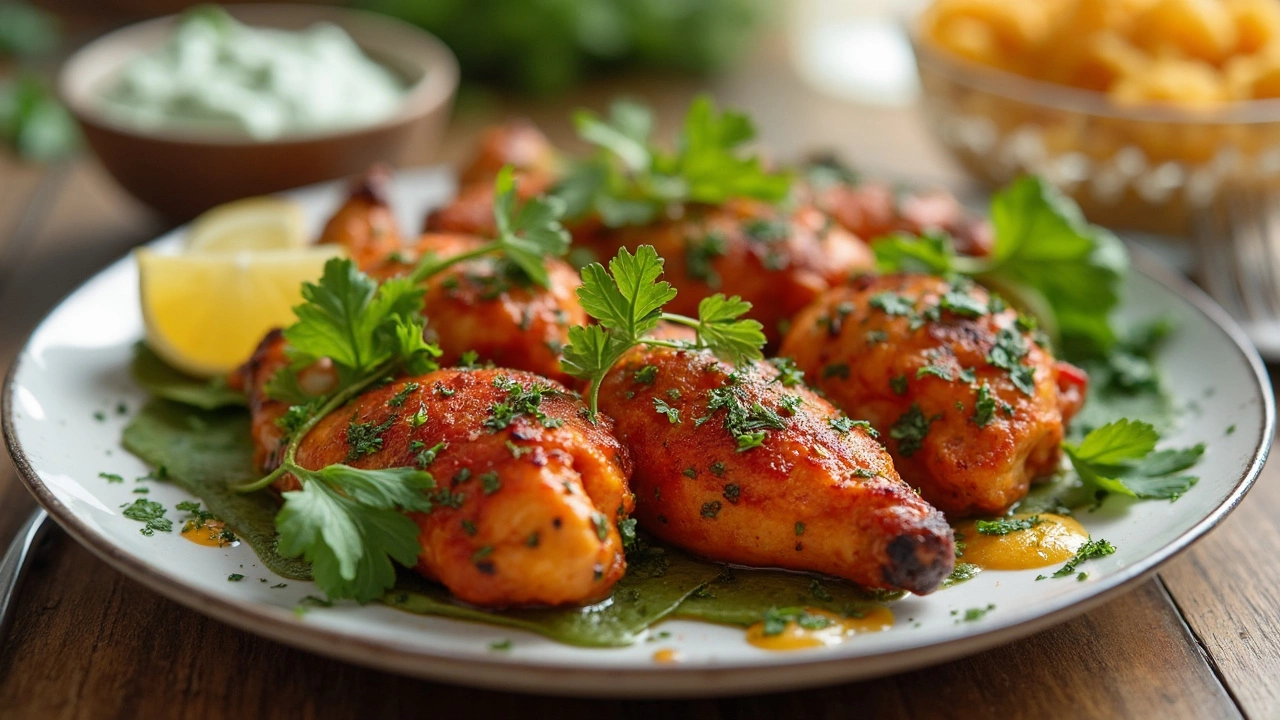We all love a plate of sizzling tandoori chicken, don’t we? But ever stopped to wonder how healthy it really is? Let's break it down. Tandoori chicken is a staple in many Indian households and has found its way into menus globally. It's essentially chicken marinated in yogurt and a blend of spices, then cooked in a tandoor—a clay oven. Sounds mouth-watering, right?
Nutritionally, tandoori chicken is somewhat of a mixed bag. The chicken itself is a great protein source, essential for muscle growth and repair. Then there's the yogurt marinade which adds probiotics, beneficial for gut health. But we can't ignore those pesky concerns about sodium and cooking methods. Typically, this dish is high in protein but can be high in sodium, depending on the spice mix used.
- Nutritional Overview
- Traditional Preparation
- Health Benefits
- Potential Concerns
- Healthier Alternatives
Nutritional Overview
When it comes to knowing how healthy our food really is, it’s all about diving into those nutritional facts. So, what's the lowdown on tandoori chicken? At its core, tandoori chicken is a protein-rich dish, and protein is essential for building muscle, keeping energy levels up, and just about every bodily function you can imagine.
Protein and Calories
A typical serving of tandoori chicken, let's say about 100 grams, packs a punch with roughly 13–15 grams of protein. That's nearly a quarter of most people’s daily protein needs. Calorically, it isn’t too overwhelming either—usually around 190–200 calories for the same serving size. This makes it a great option for those watching their caloric intake but still wanting something filling.
Nutrients in Spices and Marinade
The magic really happens in the marinade, which uses yogurt and a bunch of spices like turmeric, cumin, and ginger. Yogurt is not only protein-rich but also adds some calcium and probiotics for gut health. Spices like turmeric contain curcumin, known for its anti-inflammatory properties, and ginger may aid digestion. So, the spices aren't just for taste; they're helping your body too.
Fat and Sodium Content
But it's not all sunshine and rainbows. The fat content varies based on how much oil or ghee is used, albeit usually moderate. The real concern is sodium. Commercially prepared versions might have a high sodium content which can be a risk factor for high blood pressure. It's often good to DIY at home where you can control the salt levels.
Essential Vitamins and Minerals
The spices bring along a host of vitamins and minerals: iron from the chicken and a bit of vitamins B6 from the spices. Sure they're not in whopping amounts but every bit helps, right?
| Component | Amount per 100g |
|---|---|
| Calories | 190-200 |
| Protein | 13-15g |
| Total Fat | 5-8g |
| Sodium | 600-700mg |
All in all, tandoori chicken can be a healthy dish when prepared mindfully. Focus on the spice blend, opt for lean cuts of chicken, and be mindful of any extra salt or oil used. With these tweaks, you might just have a nutritious winner on your plate!
Traditional Preparation
Making tandoori chicken involves some straightforward yet flavorful steps. To start, you’ll need some chicken pieces—bone-in is traditional but boneless works too. The magic really begins with the marinade.
The marinade consists of yogurt and a mix of spices. Why yogurt? It’s not just about taste. The lactic acid in yogurt helps tenderize the chicken, making it juicy and flavorful. The spice blend usually includes garlic, ginger, cumin, coriander, and plenty of Indian spices like garam masala and turmeric. Don’t forget the red chili powder for that signature fiery hue.
Steps to Prepare Tandoori Chicken
- Clean and Score: Wash the chicken well and make deep cuts. This helps the marinade seep in, ensuring every bite is tasty.
- Marinate: Mix the yogurt and spices in a bowl. Coat the chicken thoroughly, ensuring the marinade gets into those cuts. Let it sit for at least a few hours or overnight for the best flavor.
- Cook in Tandoor: Traditionally, this is cooked in a clay oven. The high heat and smoky flavor from the charcoal give tandoori chicken its distinct taste. But no worries if you don’t have a tandoor—an oven or grill works too!
Cooking times can vary, but you're generally looking at around 15-20 minutes if using a tandoor or slightly longer in a conventional oven. Remember, the goal is to get that perfect charred look outside without overcooking the inside.
This traditional approach not only highlights the culinary artistry but also ensures you get the nutritional benefits without too much fuss.

Health Benefits
Let's chat about the good stuff first – the health perks of tandoori chicken. If you think it's all about taste and no health, think again! The main hero here is protein. Chicken, as we know, is an excellent protein source. A serving of tandoori chicken packs a protein punch that helps in building and repairing tissues.
But that's not all! The unique marinade is more than just a flavor bomb. It’s typically prepared with yogurt, which is known to improve digestion and boost the immune system thanks to its probiotics. Not to mention, yogurt is also a great calcium source, which is vital for bone health.
Spices with Purpose
Tandoori chicken doesn't shy away from spices either. Turmeric and cayenne pepper are often part of the mix. Turmeric is celebrated for its anti-inflammatory properties, while cayenne pepper can give your metabolism a little nudge. It's like having a tiny health kick in every bite.
| Ingredient | Benefit |
|---|---|
| Chicken | Protein for muscle growth |
| Yogurt | Probiotics for gut health and calcium for bones |
| Turmeric | Anti-inflammatory effects |
| Cayenne Pepper | Boosts metabolism |
Another subtle but significant benefit is its cooking method. Grilling or baking in a tandoor involves somewhat less fat than frying, making it a leaner choice compared to other cooking methods. So, when someone tells you that Indian cuisine can only mean heavy curries, you can just show them the bright side of tandoori chicken!
Potential Concerns
While tandoori chicken is packed with flavors, like many dishes, it's not without its concerns. Let's talk about a few of them.
Sodium Content
The marinade for tandoori chicken often includes a variety of spices, which can lead to a high sodium level, especially if you're using store-bought marinades. Too much sodium isn't great for your heart, but you can easily address this by controlling the amount of salt in your homemade mix.
Cooking Method
Traditionally, tandoori chicken is cooked in a tandoor, reaching very high temperatures. While this gives the chicken its unique smoky flavor, it can also produce heterocyclic amines (HCAs) and polycyclic aromatic hydrocarbons (PAHs), compounds that form when meat is cooked over an open flame. These have been linked to an increased cancer risk. Grilling at lower temperatures or using an oven can help reduce these risks.
Calories and Fats
Though the dish itself is protein-rich, pairing it with heavy sides like naan or buttery rice can bump up the calorie intake. Being mindful of portion sizes and accompanying dishes can keep your meal balanced.
Marinade Ingredients
Sometimes, artificial colors are added to give the chicken a bright red color, which might not be great for your health in the long run. Opting for natural color sources like beetroot powder or skipping it altogether can make a big difference.
Addressing these potential concerns can make tandoori chicken a healthier option without compromising on flavor. It's all about making informed choices!

Healthier Alternatives
Craving tandoori chicken but worried about the health aspects? Don’t fret! There's a way to enjoy this delicious dish without feeling guilty. By tweaking the traditional recipe, you can whip up a more health-friendly version at home. Let’s dive into some practical tips!
Lean Cuts and Ingredients
First off, the cut of chicken you use matters. Opt for skinless chicken breasts instead of thighs to cut down on fat content. When it comes to the tandoori chicken marinade, swap regular yogurt with Greek yogurt. It’s thicker, richer in protein, and still brings all those creamy vibes that make your marinade awesome.
Spice it Up Smartly
Sure, spices are the heart and soul of tandoori chicken. But it’s easy to go overboard with salt. Try using sea salt or even reduce the amount entirely by amplifying other spices like cumin and turmeric. These spices not only pack a punch in flavor but are known for their anti-inflammatory properties.
Grill Over Fry
Preparing tandoori chicken in a tandoor can be tough at home, so grilling is your next best bet. Grilling reduces the need for extra oils (yay for heart health!). Just make sure you've got a decent non-stick grill pan or oven setup.
Fiber-Rich Sides
Who says you can't have the sides too? Pair your chicken with whole-grain naan or a fresh salad. A simple cucumber salad with onions, tomatoes, and a splash of lemon makes for a refreshing and fiber-rich side dish to balance things out.
Light Marinade Variations
Fancy mixing it up? Use lemon or lime juice instead of oils in your marinade. Both lend a zesty kick without adding unwanted calories.
With these swaps, you'll be savoring your favorite Indian dish with a healthier twist! So next time those cravings kick in, you know exactly how to enjoy tandoori chicken without any dietary concerns.
